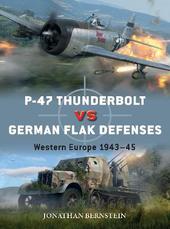
|
P-47 Thunderbolt vs German Flak Defenses: Western Europe 1943-45
Paperback / softback
Main Details
| Title |
P-47 Thunderbolt vs German Flak Defenses: Western Europe 1943-45
|
| Authors and Contributors |
By (author) Jonathan Bernstein
|
|
Illustrated by Jim Laurier
|
|
Illustrated by Gareth Hector
|
| Series | Duel |
|---|
| Physical Properties |
| Format:Paperback / softback | | Pages:80 | | Dimensions(mm): Height 248,Width 184 |
|
| Category/Genre | Second world war |
|---|
| ISBN/Barcode |
9781472846297
|
| Classifications | Dewey:940.544 |
|---|
| Audience | | General | | Professional & Vocational | |
|---|
|
Publishing Details |
| Publisher |
Bloomsbury Publishing PLC
|
| Imprint |
Osprey Publishing
|
| NZ Release Date |
16 November 2021 |
| Publication Country |
United Kingdom
|
Description
Since the end of World War 2, the tactical air war over Europe has been largely overlooked by historians and authors alike in favour of analysis of the higher profile strategic bombing campaign. Involving just as many aircraft as the daylight heavy bombing campaign, the fighter-bombers (principally of the Ninth Air Force) wreaked considerably more havoc on German ground forces. Indeed, Thunderbolt units undertaking such missions effectively complemented the strategic campaign, ensuring the defeat of Nazi Germany. P-47 pilots paid a high price to achieve this victory, however, as the German flak arm was well equipped (nearly a quarter of all war-related production was devoted to anti-aircraft weaponry) with weapons of various calibres to counter tactical air power's low to medium altitude threat. The USAAF four numbered air forces that saw action over the European continent suffered significant fighter-bomber losses to flak. The principle fighter-bomber from the summer of 1944 through to VE Day was the P-47D, with both dedicated ground attack units and squadrons that had completed their bomber escort tasking seeking out targets of opportunity across occupied Western Europe. While heavy-calibre anti-aircraft fire was intended to both shoot down enemy aircraft and force bombers to drop their ordnance sooner or from higher altitudes, thus reducing bombing accuracy, low-altitude flak batteries put up a virtual 'wall of steel' for enemy fighter-bombers to fly through. Damaging a low-flying fighter-bomber made it easier for other flak gunners to track, engage and destroy it. Innovations like lead-computing gunsights gave gunners a higher probability of intercepting low-altitude fighters. Conversely, the appearance of air-to-ground rockets beneath the wings of P-47s gave pilots better standoff range and a harder-hitting punch when dealing with low and medium altitude flak units. This volume analyses the tactics and techniques used by both P-47 fighter-bomber pilots and German flak gunners, featuring full-colour illustrations to examine the Allied tactical air power in Europe from 1943 and how German defences were overpowered by the air threat.
Author Biography
Jonathan Bernstein is an aviation author, historian, former attack helicopter pilot and current director of the US Army Air Defense Artillery Museum. He is the author of three Osprey Combat Aircraft volumes, and has also had books published by Squadron/Signal Publications and Elephant Books. Jonathan is a frequent contributor to National Guard Magazine, Supply Line and Armor Journal.
|